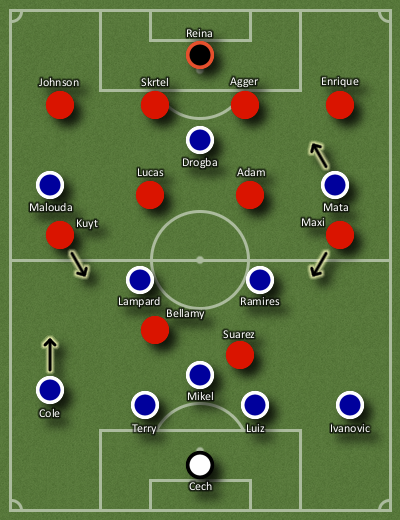Before the game on Sunday, Liverpool had conceded the fewest amount of shots of any of the Premier League teams this season (38), as well as a league-high five errors leading to goals. At the same time, Chelsea had failed to score in five of their last seven league games against Liverpool. With this background, Liverpool must have fancied their chances in this one.
Starting strategies
Chelsea started with their trademark 4-1-2-3 with a very high defensive line and heavy pressing from the front. Mikel stayed deep, almost as a third back, allowing both Cole and Ivanovic to push forward and support the attacking five. This provided natural width and also allowed them to press the opposition higher up the field.
It was surprising to see Liverpool start with a 4-4-2 formation – this was the first time they had done so in a “big” game other than the derby. Still, it made tactical sense. Liverpool defended with two solid banks of four, allowing them to be 8 v 5 or 8 v 7 (depending on whether or not the Chelsea full backs got forward) in defensive positions. Because of how high up the pitch Chelsea played, Liverpool were very deep. Suarez and Bellamy played around the half way line, sometimes deeper – by contrast, the Chelsea defenders were often on or beyond that line. This deep, compact game helped Liverpool as it closed off the space for the home team between the lines, through the channels or in behind. A couple of times Mata found the space to cut in from the right, but in both cases he failed to provide a creative spark or direct attacking presence. Chelsea offered little danger from overlapping runs from full backs or a driving force through the centre. Thus, they were limited to long balls up to Drogba who was often crowded out by Agger and Skrtel.
Even without a relentless pressing approach, Liverpool had more first-half tackles (18 to Chelsea’s 11), with over half of them successful (11 to Chelsea’s 7). This was because Liverpool managed to physically block Chelsea’s attacks. When the home team got the ball, Liverpool adopted their banks of four, focusing on defensive shape. But whenever a Chelsea player got within range of a red shirt, the Liverpool player would engage him. All of this was an excellent example of the “mixed pressing” approach I have talked about in recent articles on this site.
Liverpool’s front four, given their deeper position and the fact that they were playing very close to each other, were best suited to pressing the opposition in the centre of the field, helping each other to double up on whoever was on the ball. The central midfielders and back four created a 4+2 blockade behind them, completely smothering the space for the Chelsea attack.
The compact nature of the away side allowed them to bypass Chelsea’s closing down. They could pass to each other quickly over a short distance and move around the defenders. Once they got to the centre circle, they looked to feed the wingers and the strikers who broke forward quickly, interchanging positions. From there they fed each other in the gaps left by Chelsea players who were slightly out of position due to the heavy pressing.
The problem for Chelsea was that their closing down was leaving huge gaps between the back three (the centre backs plus Mikel) and the rest of the team. This was exacerbated by the lack of pace of Lampard and Drogba in that key zone in the middle of the park. The covering players – specifically Terry and Mikel – are also generally less mobile and so the gaps were not filled quickly enough. Only David Luiz really had the mobility to cover.
Liverpool targeted this space from the beginning of the game, and in the opening ten minutes there were several occasions when a red player managed to break through it – often it involved Suarez sending a ball through to Maxi cutting from the left.
After this period, Bellamy and Kuyt switched places which resulted in three good attacks down the right, each involving either Bellamy or Johnson dribbling down the wing and creating havoc in the box. Ten minutes later, they swapped back.
The gap problem was evident in the thirty-third minute when Liverpool opened the scoring. First, Mikel’s passing options were all blocked, which led him to hesitate and he got caught in possession by Adam. Second, it was clear that the mixed approach was working as the passing options had been marked by Liverpool’s front four, freeing Adam to push forward closing down and eventually make the tackle.
Chelsea’s half-time switch
The rest of this post is for subscribers only
[ttt-subscribe-article]
